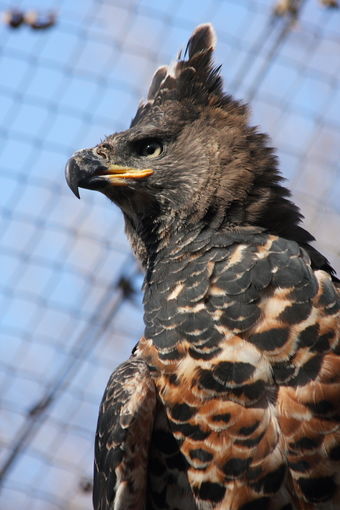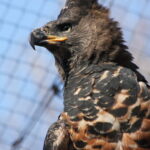Crowned eagles, like other eagle species, have exceptional eyesight that is significantly sharper than human vision. Their eyes are uniquely adapted for hunting and navigating in various lighting conditions, including low-light environments.
Crowned Eagles’ Eyesight Adaptations
Crowned eagles have several adaptations that contribute to their exceptional eyesight:
-
Fovea with High Cone Cell Density: Crowned eagles have a fovea, the central part of the eye with a higher density of cone cells, with approximately one million cells per mm2. This is significantly higher than the 200,000 cells per mm2 in human eyes, allowing crowned eagles to see details with remarkable clarity and distance.
-
Increased Rod Cell Percentage: Crowned eagles have a greater percentage of rod cells, which are responsible for low-light vision and motion detection. This enables them to hunt and navigate effectively in various lighting conditions.
-
Ultraviolet Vision: Like some other birds of prey, crowned eagles can see into the ultraviolet spectrum, allowing them to perceive colors and patterns that are invisible to humans. This can be advantageous for detecting camouflaged prey or distinguishing between healthy and unhealthy individuals within a species.
-
Binocular Vision and Wide Field of View: Crowned eagles’ eyes are positioned on the front of their heads, providing them with binocular vision and a wide field of view. This allows them to accurately judge distances and depth, which is crucial for their hunting and flying skills.
-
Nictitating Membrane: Crowned eagles have a nictitating membrane, a thin, semi-transparent third eyelid that protects their eyes and functions as a “wiping” mechanism to keep the eye clean and moist.
Night Vision Capabilities of Crowned Eagles
While crowned eagles do not have the same level of night vision as nocturnal animals like owls, their rod cells still provide them with some degree of low-light vision. This allows them to be active during twilight hours and navigate in dimly lit environments, although they may not be as effective as during the day.
Comparison to Human Vision
Compared to human vision, crowned eagles have several advantages:
| Characteristic | Crowned Eagles | Humans |
|---|---|---|
| Fovea Cone Cell Density | ~1 million cells/mm2 | 200,000 cells/mm2 |
| Ultraviolet Vision | Yes | No |
| Binocular Vision | Yes | Yes |
| Field of View | Wider | Narrower |
| Night Vision | Some low-light vision | Limited |
The combination of these visual adaptations makes crowned eagles highly skilled hunters and navigators, capable of detecting and pursuing prey with remarkable precision, even in challenging lighting conditions.
Conclusion
Crowned eagles possess exceptional eyesight, with a range of adaptations that allow them to see with remarkable clarity, depth perception, and low-light vision. While they may not have the same level of night vision as nocturnal animals, their visual capabilities still give them a significant advantage in hunting and navigating their environment, even during twilight hours.
References:
– https://animals.sandiegozoo.org/animals/crowned-eagle
– https://en.wikipedia.org/wiki/Eagle_eye
– https://www.reddit.com/r/askscience/comments/nks3z/eagles_have_sharper_vision_whats_it_look_like/


